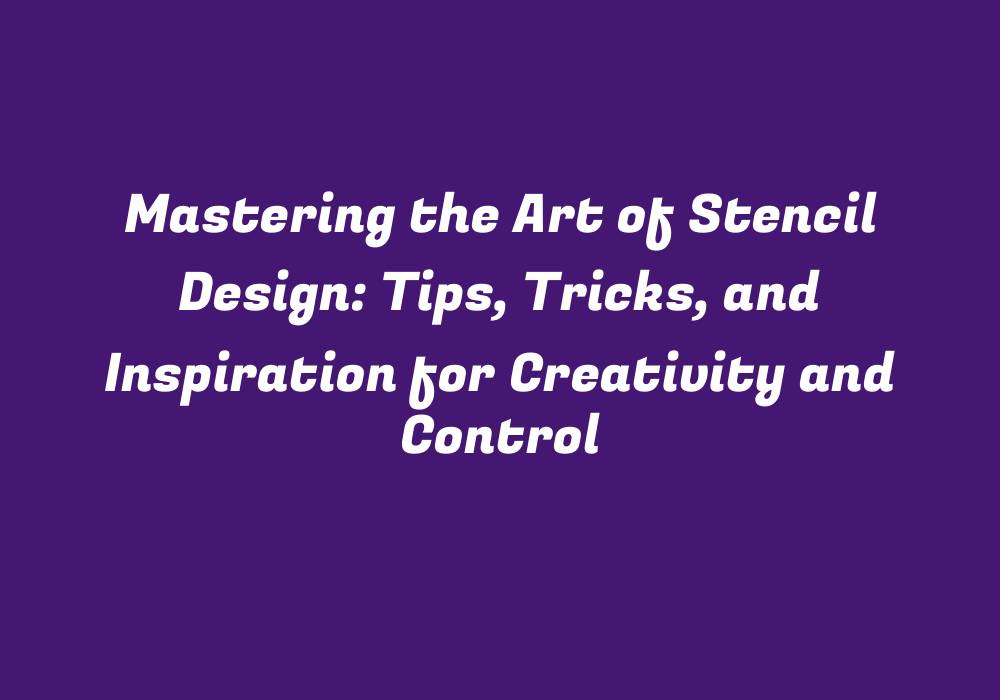Introduction
Stencil design is an art form that has been gaining popularity in recent years. It combines creativity with simplicity and control, offering a range of visual effects and possibilities. Whether you’re a professional designer or simply someone looking to explore new artistic ventures, mastering the craft can open up endless creative opportunities. In this comprehensive article, we will cover everything you need to know about stencil design, from its history and applications to essential tips, tricks, and inspirations for honing your skills.
The Evolution of Stencil Design
Stencils have been used since ancient times in various forms – such as pottery decoration, woodblock printing, and even for creating body art in religious ceremonies. However, their widespread use as a popular craft tool began during the Renaissance when stencils were employed to decorate walls of homes, churches, and public buildings. Today, stencil design has found its way into graphic design, digital illustration, and street art.
Applications of Stencil Design
Stenciling can be applied in numerous ways to create visually appealing designs for various purposes. Here are some common applications:
1. Artistic Expression – Stencils enable artists to express their creativity through patterns, shapes, and figures on various surfaces like paper, canvas, and fabric. They are an efficient tool for quickly producing multiple copies of a design while ensuring consistency in color and technique.
2. Home Decor – Whether you’re looking to revamp your living space or add some personal touches to your office, stencils can be used on walls, floors, furniture, and other household items to create beautiful and unique decorative elements.
3. Graphic Design – In the field of graphic design, stencil art is utilized for creating typographic designs, logos, and patterns that add depth and visual interest to various marketing materials such as flyers, posters, and websites.
4. Street Art – Graffiti artists have taken advantage of stencils’ ease of use and portability to create intricate murals, taglines, and other artistic expressions on walls, fences, and public spaces worldwide.
5. Craft Projects – Stencil design is not limited to large-scale art projects; they can also be used for personalized gifts, greeting cards, home organization, and more in the realm of crafting and DIY enthusiasts.
Tips and Tricks for Mastering Stencil Design
1. Choosing Your Medium: Decide on the surface you’ll work with – from paper and canvas to wood and metal. Each medium has its unique properties that will impact the final result, so experiment until you find the one that best suits your project.
2. Preparing Your Stencil Materials: Select a sturdy material such as acrylic or plastic for your stencil designs. You can create your own stencils using transparent materials and cut them out with scissors, x-acto knives, or specialized cutting tools. Alternatively, purchase pre-made stencils to save time and effort.
3. Transferring Your Design: Carefully transfer your desired design onto the stencil material by tracing it with a pen or pencil, or using adhesive vinyl for more precision. Make sure the lines are well-defined and easily visible through the stencil’s surface.
4. Preparing Your Workspace: Ensure that you have adequate space and the necessary tools at hand before starting to work on your design project. This may include pens, markers, brushes, paints, colorful materials like tissue paper or glitter, and any other supplies you want to incorporate into your stencil art.
5. Stenciling Techniques: Familiarize yourself with various stenciling methods such as airbrushing, sponging, spray painting, and more to achieve different textures and effects in your designs. Practice these techniques on scrap materials before using them on the final design for better results.
6. Experimentation: Don’t be afraid to try out new ideas and combinations of materials, colors, and patterns. Stencil design offers endless creative opportunities, so allow yourself some room to explore and make mistakes as part of your learning process.
7. Practice Makes Perfect: As with any craft, patience and practice are key elements in mastering the art of stencil design. Continuously refine your skills by creating new designs, trying out different techniques, and observing the work of others to develop a unique style that sets you apart.
Inspiration for Stenciling Projects
Finding inspiration is crucial when working on any creative project, including stencil art. To spark your imagination, consider these sources:
1. Nature – Observe shapes, patterns, and textures found in the natural world to create organic and unique designs.
2. Architecture – Admire the beauty of different architectural styles and their intricate details for inspiration when creating geometric or intricate stencil art.
3. Art History – Study classic works of art and discover how famous artists used lines, shapes, and patterns in their pieces. Emulate these techniques to create your own unique designs.
4. Pop Culture – Keep up with the latest trends in music, movies, TV shows, or social media memes to find inspiration for creating stencil designs that resonate with a broader audience.
5. Personal Interests and Experiences – Use your personal interests and experiences as fuel for creating meaningful, engaging, and relatable art. Stenciling allows you to express yourself in various ways while reflecting on the world around you.
Conclusion
Stencil design is an accessible and versatile craft that enables artists of all levels to explore their creativity and control through a range of techniques and materials. By following our tips, tricks, and sources of inspiration, you’ll be well on your way to mastering the art of stencil design while unlocking a world of possibilities for your artistic endeavors.
